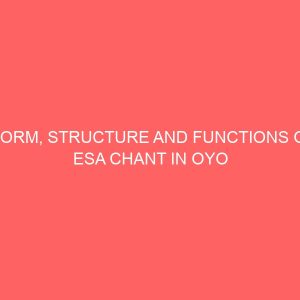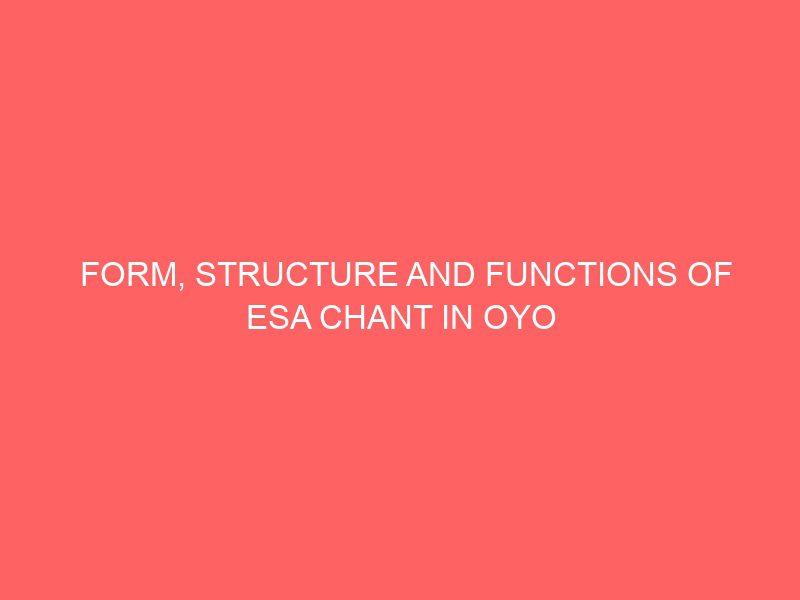Description
ABSTRACT
Music has an important role in ones life and in any festival in Yoruba land, this is why this project will then be limited to the descriptions of form, structure and functions of Esa chant in Oyo Yoruba speaking area, Fiditi, which has been in existence from old time and is said to have originated from time in memorial. It is annually celebrated between June and July in remembrance of their forefathers.
The music rendered along with the chanting is purely traditional and it symbolized the culture of the Yorubas. Most of the songs teaches the moral aspect of life while some expresses their mind for their love ones.
While making this research, it was discovered that chanting are made for entertainment, coronation, naming ceremony, traditional wedding ceremony and as well energizes.
It was also made to the readers that the researcher was aimed at studying the origin of Esa chant and its performance techniques, bringing to light the different types of Esa chant in Fiditi town, studying the songs emanated from Esa chant for form, structure and analytical purpose, to document Esa chant and its song for future references and finally to make the detail information about the Esa chant more available for the public consumption.
CHAPTER ONE
1.0 INTRODUCTION
Over the years, scholars had written on several types of Yoruba vocal genres such as Ewi, Ijala and Rara among others. But, there seems to be little or no documents on the side of Esa chant. The reason for this might be that very little information is available on the performers of Esa.
In this study, we are going to examine the form, structure and functions of Esa chant as it is being practiced in Fiditi town. Esa is a form of Yoruba principal chant that is commonly practiced among the traditional Yoruba of western Nigeria. According to Adeegbite 1985, there are two types of Esa chants. The Esa Orisa and Esa Egungun. Esa is commonly encountered at the traditional rituals or religious ceremonies, while Esa Egungun is associated with Egun Alarinjo or pidanpidan.
People all over the world have different beliefs and practices which developed into behavioural patterns ad giving the distinctive identities that is referred to as their culture. Emphasis is going to be placed on Esa Egungun because they make much use of Esa chant than Esa Orisa.
A great number of Yoruba vocal music are chanted. Most of the chants share common performance features. The texts of the chants can be used interchangeably from one chant to another. Music that are cited in the study are good examples of chants for different occasions. One notable characteristic of all the chants is the sporadic use of refrain during the course of chanting.
The general performance is evaluated by what has been said by the chant, including the way he has said it. The songs involved are always very short, popular and rhythmic as to allow participation. All the same, the aesthetic of the performance depends on how frequent the short songs are used with their relevance to the text of the chant.
1.1. Background to the Study
Yoruba is one of the most important ethnic groups found in the South Western part of Nigeria. They occupy states such as Oyo, Ondo, Osun, Ogun, Lagos, Ekiti and part of Kogi and Kwara. It would be very interesting to note that the language of the people is of various dialects. These include; Oyo, Onko, Ijesa, Ijebu, Egba and so on. Of all these dialects the one that is accepted in writing is the Oyo dialect spoken by the Yoruba occupants of important towns such as; Oyo, Ibadan, Ogbomoso, Osogbo and smaller societies that are found around the towns.
The Yoruba are very rich in culture. They are quite unique in terms of language, dressing, greetings, religion, arts and crafts, dance and of course much which is the focus of this research. There is hardly any occasion that is not celebrated with the use of music. In other words, they have music for all occasions. These include Religion, Naming, Marriage, House Warming, Funeral, Festivals, Coronation of Kings and Chiefs, Politics, Sports and games and so on.
The ethnic group is also blessed with festivals of various types and these festivals are attached with various types of music. Music performs various important functions during any of the festivals. It is also important to note that these festivals are attached with various deities worshipped by the people. In other words, various festivals that are celebrated by the people are usually named after the deities with which it is celebrated. For example, Sango festival was named after Sango, Ogun festival named after Ogun, Oro festival named after Oro, Egungun festival named after Egungun and so on.
Among the important musical genres is Esa which is attached to Egungun festival and which is the focus of this research. It is hoped that discussion and analysis covered in the area of Esa Egungun chant will seriously enlighten the readers of this work. Esa chant is still much in existence, it is the significance of this musical genre that gave the researcher the encouragement to collect data so that detail information will be made available for public consumption. It is believed that this would lead to carrying out further studies in the area.
1.2. Aims and Objectives
The aims and objectives of this study are as follows:
i To study the origin of Esa chant and its performance techniques
ii To bring to light the different types of Esa chants in Fiditi town.
iii To study the songs emanated from Esa chant for form, structured and analytical purposes.
iv To document Esa chant and its songs for future references.
v To make the detail information about the Esa chant more available for the public consumption.
1.3. Significance of the Study
The study will attempt to analyse and document the important aspect of Esa chant in Fiditi town. The various studies carried out by ethnomusicologists on traditional Nigerian music have not only helped toward documenting traditional Nigerian musical heritage, but also shed more light on the nature, structure, context as well as functions of different examples of our precolonial musical traditions.
There is need to continue to conduct research into various aspect of traditional Nigeria music especially when considering the eroding impact of western civilization, Christianity and Islamic cultures on our traditions.
As a contribution to the scholarly efforts at documenting and understanding aspect of our traditional cultures, I have decided to examine the form, structure and functions of Esa chants in Oyo Yoruba speaking area; a case study of Fiditi town.
1.4. Statement of the Problem
The advent of Christianity and Islam in Africa had brought a significant negative impact on the traditional African religion in that the former are equate with civilization and progress while the latter is linked with backwardness voodism and anything fetish and diabological.
Majority of people therefore shifted to the progressive religions at the expense of the traditional one which is why few people practice the traditional religion that is often derogatorily tagged paganism.
Esa Egungun among several Yoruba oral chants is not easy to come by and scholarly works are also difficult to get. This could be explained against the backdrop that the few practitioners do not willingly give needed information to researchers.
In order to get more people informed through proper documentation and analysis, this research work is quite inevitable.
1.5. Scope of the Study
This study is carried out in Oyo Yoruba speaking area, Afijio Local Government Oyo, Oyo State, Nigeria. The scope of this study is therefore limited to Afijio Local Government, Oyo, Fiditi town. This is because the Esa chant is been preserved and performed in Fiditi town and it is common to the Fiditi people.
1.6. Limitation of the Study
Despite the fact that the researcher is aiming at coming out with useful and reliable information on how the Esa chant is being structured, performed and functions, the time available to carry out the research may not be enough. This is because the research is going to involve a lot of activities such as the conduction of interview, recording and transcription of the music used while chanting the Esa. A lot of money is also needed to finance the project and as such insufficient money may also be a limitation of the study. It is also emphasized that not all the respondents would like to cooperate as expected. However, efforts would be made as much as possible to come out with a successful, reliable and highly informative research.








Reviews
There are no reviews yet.